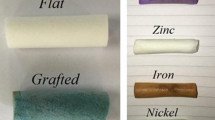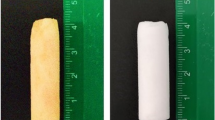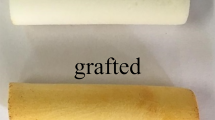Abstract
The present study was conducted for the synthesis of a novel supermacroporous monolithic hydrophobic adsorbent for lysozyme (Lyz) selected as a model protein from aqueous solution. After preparation of poly(2-hydroxyethyl methacrylate-co-N-methacryloyl-(l)-tyrosine methyl ester) monolithic cryogel column, 1-naphthylamine was covalently attached, and the prepared column was abbreviated as NA-Mcc. Scanning electron microscopy, Fourier transform infrared spectroscopy and Brunauer, Emmett and Teller device were utilized for the morphology, functional groups and surface area measurements of the column. Effects of several parameters including Lyz content of the adsorption solution, pH of the medium used, ambient temperature, type of salt and flow rate on the adsorption capacity of the polymeric material were examined in continuous operation. The maximum value achieved for Lyz adsorption from aqueous phase was found to be 105.8 mg/g in phosphate buffer. In addition, NA-Mcc was investigated in terms of reusability, and it was demonstrated that there is no significant change in the adsorption properties of prepared monolithic hydrophobic cryogels after 30 adsorption–desorption cycles.







Similar content being viewed by others
References
Labrou NE (2014) Protein purification: an overview. In: Methods in molecular biology, pp 3–10
Çetin K, Denizli A (2019) Microcryogels as plastic antibodies for transferrin purification. Process Biochem 79:174–184. https://doi.org/10.1016/j.procbio.2018.12.020
Chen L, Xu S, Li J (2011) Recent advances in molecular imprinting technology: current status, challenges and highlighted applications. Chem Soc Rev 40:2922. https://doi.org/10.1039/c0cs00084a
Lozinsky VI, Plieva FM, Galaev IY, Mattiasson B (2001) The potential of polymeric cryogels in bioseparation. Bioseparation 10:163–188
Miao Y, Sun X, Lv J, Yan G (2019) Phosphorescent mesoporous surface imprinting microspheres: preparation and application for transferrin recognition from biological fluids. ACS Appl Mater Interfaces 11:2264–2272. https://doi.org/10.1021/acsami.8b17772
Turner NW, Jeans CW, Brain KR et al (2006) From 3D to 2D: a review of the molecular imprinting of proteins. Biotechnol Prog 22:1474–1489
Diogo MM, Ribeiro SC, Queiroz JA et al (2001) Production, purification and analysis of an experimental DNA vaccine against rabies. J Gene Med 3:577–584. https://doi.org/10.1002/jgm.218
Yavuz H, Odabaşı M, Akgöl S, Denizli A (2005) Immobilized metal affinity beads for ferritin adsorption. J Biomater Sci Polym Ed. https://doi.org/10.1163/1568562053783713
Kaya M, Odabaşı M, Mujtaba M et al (2016) Novel three-dimensional cellulose produced from trunk of Astragalus gummifer (Fabaceae) tested for protein adsorption performance. Mater Sci Eng C 62:144–151. https://doi.org/10.1016/j.msec.2016.01.047
Acet Ö, Baran T, Erdönmez D et al (2018) O-carboxymethyl chitosan Schiff base complexes as affinity ligands for immobilized metal-ion affinity chromatography of lysozyme. J Chromatogr A 1550:21–27. https://doi.org/10.1016/j.chroma.2018.03.022
Acet Ö, Önal B, Sanz R et al (2019) Preparation of a new chromatographic media and assessment of some kinetic and interaction parameters for lysozyme. J Mol Liq 276:480–487. https://doi.org/10.1016/j.molliq.2018.12.037
Coskun O (2016) Separation techniques: Chromatography. North Clin Istanbul. https://doi.org/https://doi.org/10.14744/nci.2016.32757
Yılmaz F, Bereli N, Yavuz H, Denizli A (2009) Supermacroporous hydrophobic affinity cryogels for protein chromatography. Biochem Eng J 43:272–279. https://doi.org/10.1016/j.bej.2008.10.009
Dedeoğlu N, Arslan M, Erzengin M (2014) Purification of holstein bull semen paraoxonase 1 (PON1) by hydrophobic interaction chromatography and investigation of its inhibition kinetics by heavy metals. Biol Trace Elem Res 158:29–35. https://doi.org/10.1007/s12011-014-9916-8
Altıntaş EB, Denizli A (2009) Monosize magnetic hydrophobic beads for lysozyme purification under magnetic field. Mater Sci Eng C 29:1627–1634. https://doi.org/10.1016/j.msec.2008.12.028
Shepard CC, Tiselius A (1949) The chromatography of proteins. The effect of salt concentration and pH on the adsorption of proteins to silica gel. Discuss Faraday Soc 7:275. https://doi.org/https://doi.org/10.1039/df9490700275
Ghose S, Tao Y, Conley L, Cecchini D (2013) Purification of monoclonal antibodies by hydrophobic interaction chromatography under no-salt conditions. MAbs 5:795–800. https://doi.org/10.4161/mabs.25552
Murphy PJ, Stone OJ, Anderson ME (2011) Automated hydrophobic interaction chromatography column selection for use in protein purification. J Vis Exp. https://doi.org/10.3791/3087
Burden CS, Jin J, Podgornik A, Bracewell DG (2012) A monolith purification process for virus-like particles from yeast homogenate. J Chromatogr B Anal Technol Biomed Life Sci 880:82–89. https://doi.org/10.1016/j.jchromb.2011.10.044
Gedikli M, Ceylan Ş, Erzengin M, Odabaşı M (2014) A novel matrix for hydrophobic interaction chromatography and its application in lysozyme adsorption. Acta Biochim Pol 61: 731–737. https://doi.org/https://doi.org/10.18388/abp.2014_1838
Baydemir G, Türkoğlu EA, Andaç M et al (2015) Composite cryogels for lysozyme purification. Biotechnol Appl Biochem 62:200–207. https://doi.org/10.1002/bab.1259
Bulut E, Sargin I, Arslan O et al (2017) In situ chitin isolation from body parts of a centipede and lysozyme adsorption studies. Mater Sci Eng C 70:552–563. https://doi.org/10.1016/j.msec.2016.08.048
Guan YF, Lai SY, Lin CS et al (2019) Purification of lysozyme from chicken egg white using diatom frustules. Food Chem 286:483–490. https://doi.org/10.1016/j.foodchem.2019.02.023
Chen K-H, Chou S-Y, Chang Y-K (2019) Rapid purification of lysozyme by mixed-mode adsorption chromatography in stirred fluidized bed. Food Chem 272:619–627. https://doi.org/10.1016/j.foodchem.2018.06.050
Lozinsky VI, Galaev IY, Plieva FM et al (2003) Polymeric cryogels as promising materials of biotechnological interest. Trends Biotechnol 21:445–451. https://doi.org/10.1016/j.tibtech.2003.08.002
Odabaşı M, Baydemir G, Karataş M, Derazshamshir A (2010) Preparation and characterization of metal-chelated poly(HEMA-MAH) monolithic cryogels and their use for DNA adsorption. J Appl Polym Sci. https://doi.org/10.1002/app.31505
Sargin I, Arslan G, Erzengin M (2016) Interactions of bovine serum albumin with humic acid-Cu(II) aggregates in poly(hydroxyethylmethacrylate) cryogel column. J Taiwan Inst Chem Eng. https://doi.org/10.1016/j.jtice.2016.03.032
Baydemir G, Bereli N, Andaç M et al (2009) Supermacroporous poly(hydroxyethyl methacrylate) based cryogel with embedded bilirubin imprinted particles. React Funct Polym 69:36–42. https://doi.org/10.1016/j.reactfunctpolym.2008.10.007
Erzengin M, Ünlü N, Odabaşı M (2011) A novel adsorbent for protein chromatography: Supermacroporous monolithic cryogel embedded with Cu2+-attached sporopollenin particles. J Chromatogr A 1218:484–490. https://doi.org/10.1016/j.chroma.2010.11.074
Ünlü N, Ceylan Ş, Erzengin M, Odabaşı M (2011) Investigation of protein adsorption performance of Ni2+-attached diatomite particles embedded in composite monolithic cryogels. J Sep Sci 34:2173–2180. https://doi.org/10.1002/jssc.201100269
Özcan Tozak K, Erzengin M, Sargin I, Ünlü N (2013) Sorption of DNA by diatomite-Zn (II) embedded supermacroporous monolithic p(HEMA) cryogels. EXCLI J 12:670–680. https://doi.org/https://doi.org/10.17877/DE290R-7232
Baydemir G, Odabaşı M (2013) Microsphere-embedded cryogel for selective and efficient depletion of immunoglobulin G from human serum. Artif Cells Nanomed Biotechnol 41:319–326. https://doi.org/10.3109/21691401.2012.743904
Baran NY, Acet Ö, Odabaşı M (2017) Efficient adsorption of hemoglobin from aqueous solutions by hybrid monolithic cryogel column. Mater Sci Eng C 73:15–20. https://doi.org/10.1016/j.msec.2016.12.036
Ceylan Ş, Odabaşı M (2013) Novel adsorbent for DNA adsorption: Fe3+-attached sporopollenin particles embedded composite cryogels. Artif Cells Nanomed Biotechnol. https://doi.org/10.3109/21691401.2012.759125
Alkan H, Cömert ŞC, Gürbüz F et al (2017) Cu2+-attached pumice particles embedded composite cryogels for protein purification. Artif Cells Nanomed Biotechnol 45:90–97. https://doi.org/10.3109/21691401.2015.1129627
Avcibaşi N, Uygun M, Çorman ME et al (2010) Application of supermacroporous monolithic hydrophobic cryogel in capturing of albumin. Appl Biochem Biotechnol 162:2232–2243. https://doi.org/10.1007/s12010-010-8997-x
Öncel Ş, Uzun L, Garipcan B, Denizli A (2005) Synthesis of phenylalanine-containing hydrophobic beads for lysozyme adsorption. Ind Eng Chem Res 44:7049–7056. https://doi.org/10.1021/ie0506318
Wang Y, Xie Y, Zhang Y et al (2016) Anionic and cationic dyes adsorption on porous poly-melamine-formaldehyde polymer. Chem Eng Res Des 114:258–267. https://doi.org/10.1016/j.cherd.2016.08.027
Roettger BF, Ladisch MR (1989) Hydrophobic interaction chromatography. Biotechnol Adv 7:15–29. https://doi.org/10.1016/0734-9750(89)90901-4
Perkins TW, Mak DS, Root TW, Lightfoot EN (1997) Protein retention in hydrophobic interaction chromatography: modeling variation with buffer ionic strength and column hydrophobicity. J Chromatogr A 766:1–14. https://doi.org/10.1016/S0021-9673(96)00978-8
Author information
Authors and Affiliations
Corresponding author
Additional information
Publisher's Note
Springer Nature remains neutral with regard to jurisdictional claims in published maps and institutional affiliations.
Rights and permissions
About this article
Cite this article
Erzengin, M., Baydemir Peşint, G., Zenger, O. et al. Monolithic hydrophobic cryogel columns for protein separation. Polym. Bull. 79, 1485–1499 (2022). https://doi.org/10.1007/s00289-021-03568-2
Received:
Revised:
Accepted:
Published:
Issue Date:
DOI: https://doi.org/10.1007/s00289-021-03568-2




